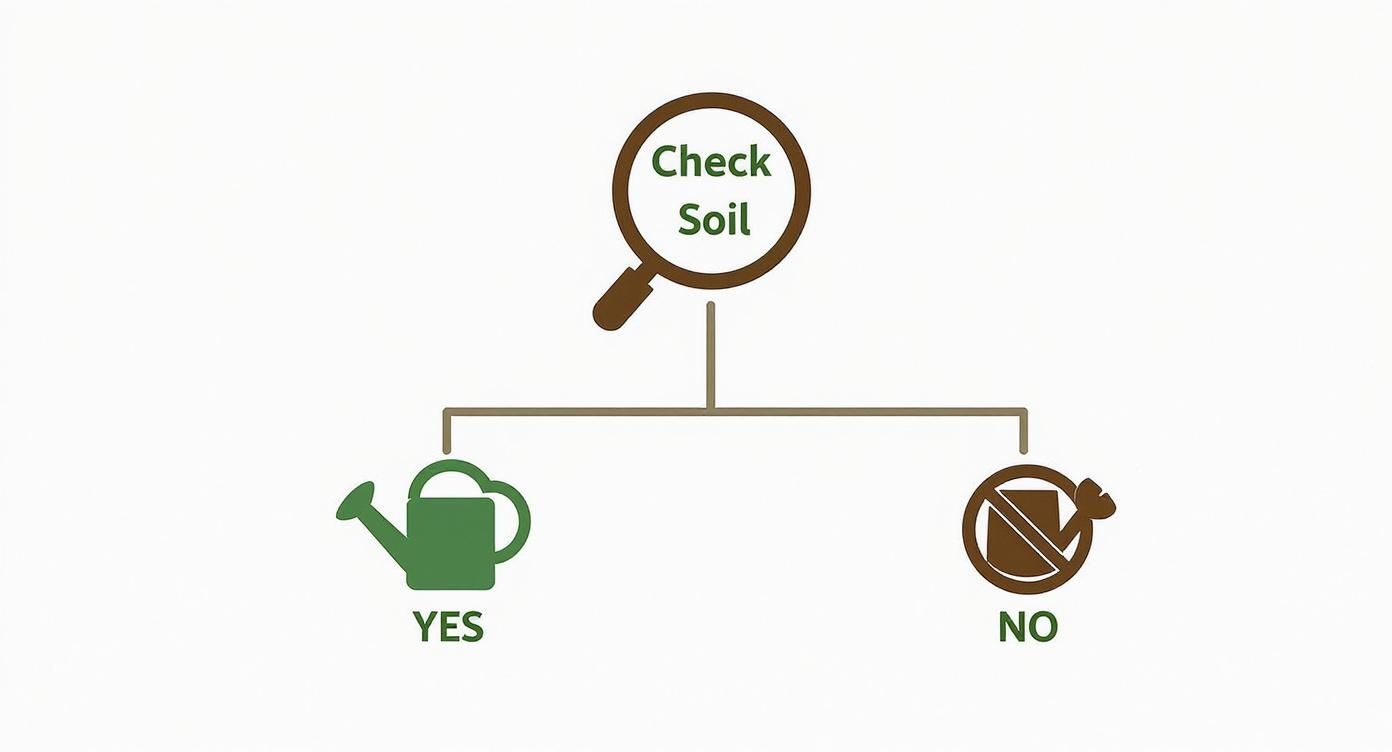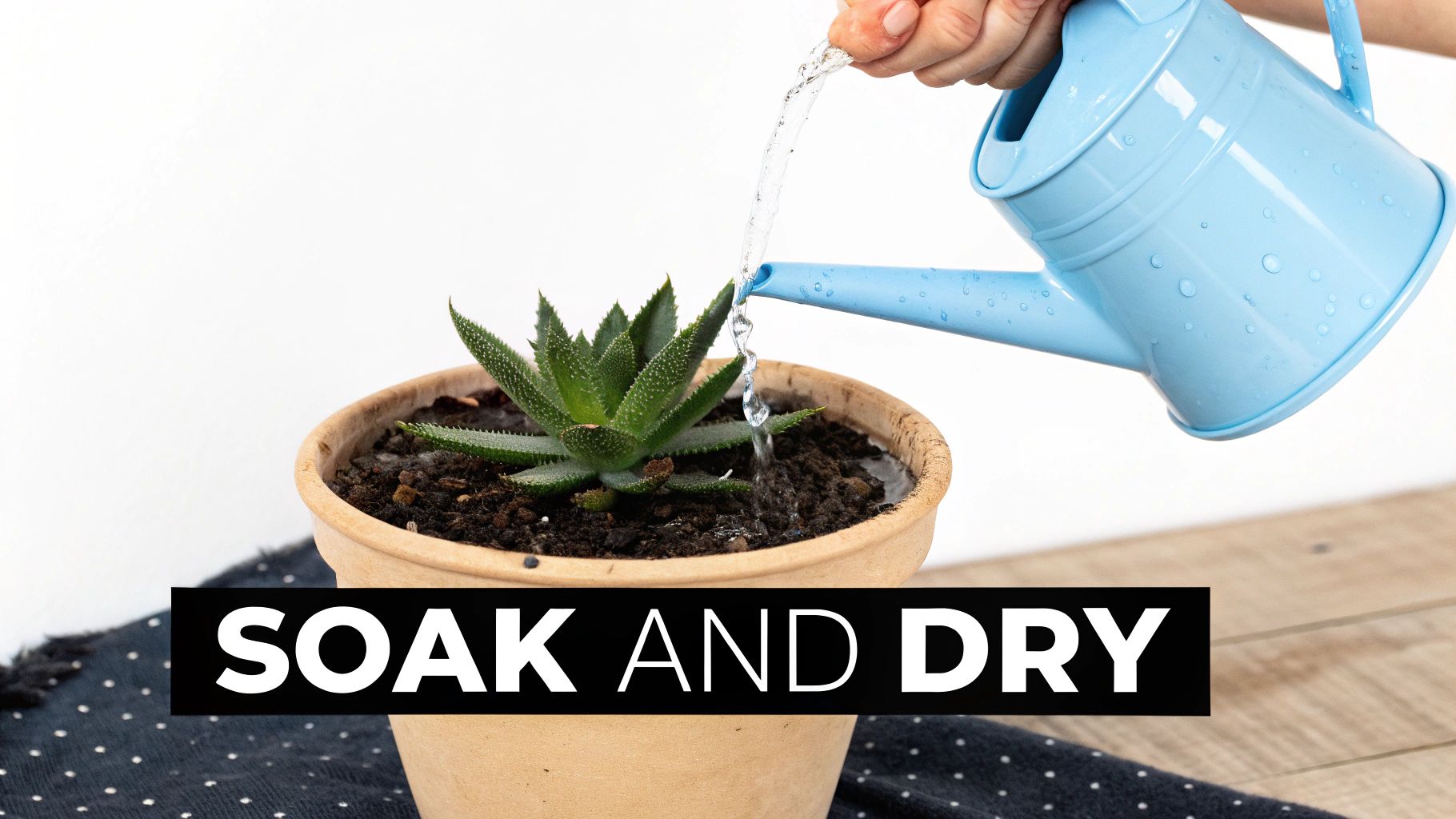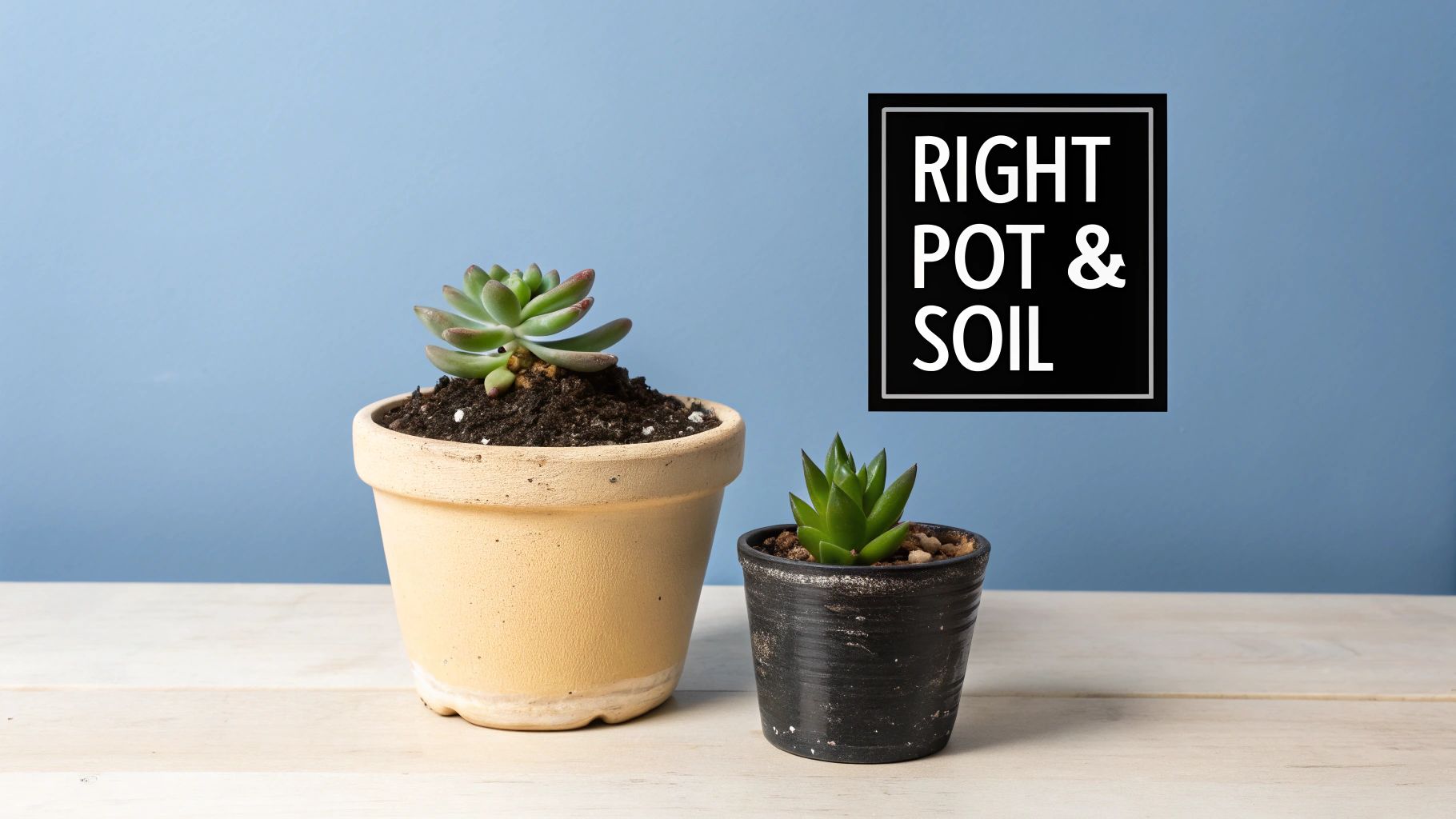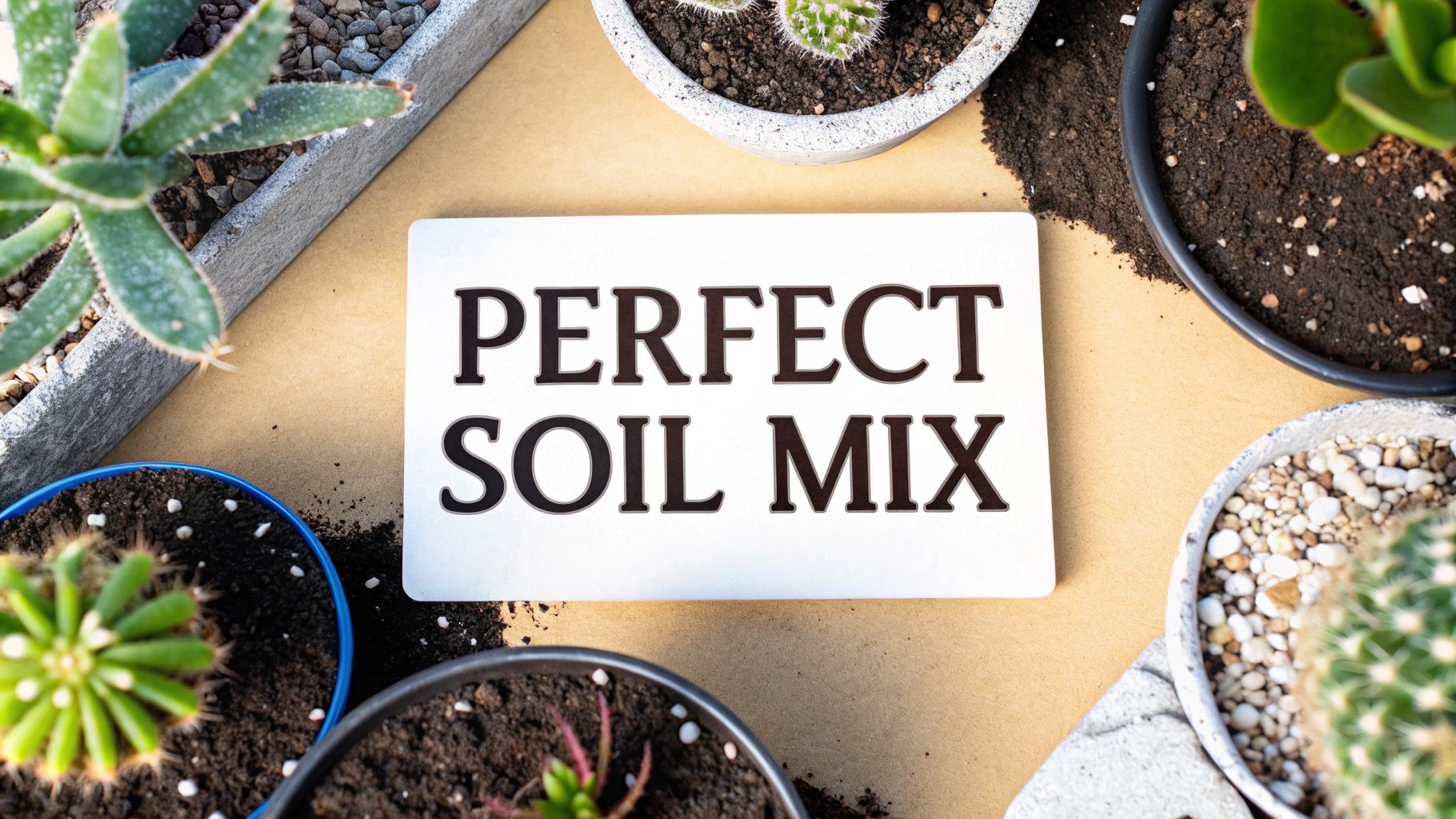When it comes to figuring out how much water your succulent needs, the best advice I can give is to completely drench the soil and then let it dry out entirely. It's a simple rhythm called the "soak and dry" method. This means you'll water thoroughly until it starts running out of the drainage holes, which might be every 2-4 weeks, give or take, depending on your home's environment. The most important thing is to forget about a rigid schedule and focus on what the soil is telling you.
The Golden Rule of Watering Succulents
If there's one thing to remember about succulent care, it's not a specific schedule or measurement. It's a simple technique that mimics how these plants live in the wild: the soak and dry method. This approach copies the rare but heavy rains succulents get in their native arid homes. Honestly, getting this right is the secret to avoiding the number one succulent killer—root rot.
Instead of giving your plant little sips of water every few days, you want to completely saturate the soil. Pour water over the soil until you see it flowing freely from the drainage holes at the bottom of the pot. This deep soak ensures the entire root system gets a chance to drink. Once that's done, the "dry" part of the cycle begins.
Let the Soil Dry Out Completely
This is the step where many well-meaning plant owners trip up. Succulents are built for drought. Their plump, fleshy leaves are little water tanks, so they actually thrive on a cycle of wet followed by dry. You have to wait until the soil is bone dry all the way through before you even consider watering again.
For most succulents sitting indoors, this cycle usually takes about two to three weeks during their active growing season in spring and summer. If you want to dive deeper into how this works for different species, our guide to cactus plant watering has some great species-specific tips.
Key Takeaway: The goal isn't just to keep the soil a little damp. It's about a full cycle of saturation followed by a period of being completely dry. This process gives the roots air and stops them from sitting in stagnant, soggy soil, which is what causes them to rot.
This simple decision tree can help you visualize whether it's time to water or wait.

As the infographic shows, the entire decision really just boils down to one thing: checking the soil first.
Why This Method Works
Succulent roots need oxygen just as much as they need water. When soil stays constantly wet, it gets compacted and literally suffocates the roots, which quickly leads to decay. Allowing the soil to dry out completely ensures those roots can breathe.
People overwater succulents more than any other plant because they're just so well-equipped to handle drought. During their winter dormancy, their water needs drop dramatically—sometimes you might only water them a couple of times for the entire season. This soak and dry rhythm is the foundation of healthy succulent growth, turning what feels like guesswork into a confident, repeatable practice.
Is Your Succulent Thirsty? A Quick Checklist
Not sure if the soil is dry enough? Here are a few reliable ways I check my own plants. Sticking your finger in is the easiest, but a wooden skewer can give you a more accurate reading deeper in the pot.
| Check Method | What to Look For (Ready for Water) | What It Means |
|---|---|---|
| Finger Test | Insert your finger up to your knuckle. It should feel completely dry with no soil clinging to your skin. | If you feel any coolness or moisture, the soil is still wet. Wait a few more days. |
| Wooden Skewer | Push a wooden chopstick or skewer to the bottom of the pot. It should come out clean and dry. | If it comes out with dark, damp soil stuck to it, there's still too much moisture at the root level. |
| Pot Weight | The pot will feel noticeably lighter than it did right after you last watered it. | A heavy pot is a sure sign that the soil is still saturated. Get a feel for both weights to learn the difference. |
| Soil Pulling Away | The soil may look slightly shrunken and pull away from the sides of the pot. | This is a visual cue that the soil has released all of its moisture and is completely dry. |
Using a combination of these checks will help you get the timing just right, ensuring you only water when your succulent truly needs it.
How Pot and Soil Choices Impact Watering

Figuring out how much to water your succulent is only half the battle. The pot and soil you choose can either be your greatest ally or your biggest enemy, completely sabotaging your best efforts. Get the combination right, and the soak-and-dry method is a breeze. Get it wrong, and you're setting the stage for root rot.
Your Pot: More Than Just a Pretty Face
Think of your succulent's pot as an active partner in the watering process. The material it’s made from has a direct say in how fast the soil dries out.
- Terracotta and unglazed ceramic pots are fantastic choices, especially if you're new to succulents. They're porous, which means they actually breathe. The pot itself wicks moisture away from the soil and allows it to evaporate, helping everything dry out much faster. This gives you a great buffer against overwatering.
- Glazed ceramic, plastic, or metal pots are a different story. Since they're non-porous, they trap moisture inside. The soil will stay wet for a lot longer. You can absolutely grow healthy succulents in them, but you have to be much more careful, always double-checking that the soil is completely dry before you even think about watering again.
Size Matters More Than You Think
The size of the pot is another huge factor. Putting a small succulent in a gigantic pot is a classic mistake and a recipe for disaster. All that extra soil holds onto water for what feels like an eternity, and the plant’s tiny root system will inevitably rot.
On the flip side, a big, root-bound succulent crammed into a tiny pot will dry out incredibly fast and will likely need more frequent drinks.
A good rule of thumb is to pick a pot that’s about 10% wider than the plant. This leaves just enough space for the roots to grow without creating a swampy mess of unused, waterlogged soil.
Drainage Is Non-Negotiable
Let's be perfectly clear: if a pot doesn't have a drainage hole, it's not a pot for a succulent. It's that simple. Without a way for excess water to escape, it just sits at the bottom, drowning the roots. This is the fastest way to kill a succulent, no matter how perfectly you water it.
Pro Tip: Please, don't fall for the old myth of putting a layer of rocks or gravel at the bottom of a pot for drainage. It doesn’t work. In fact, it makes things worse by creating what's called a "perched water table," which raises the soggy, root-rotting layer of soil closer to your plant. Always, always use a pot with a real hole.
Finally, the soil you use is your last line of defense. Regular potting mix is a death sentence for succulents because it's designed to hold water. You need a gritty, well-draining mix that allows water to flow through freely. You can buy great pre-made blends, or you can learn more about what goes into the perfect cactus and succulent soil and mix your own. This final piece of the puzzle ensures that even after a thorough drenching, your plant's roots get the air they need to thrive.
Learning to Read Your Succulent’s Thirst Signals

While dry soil is your green light to water, your succulents themselves are the real experts. They're constantly sending visual cues about their hydration levels. Think of it as learning your plant's unique language—it lets you ditch a rigid calendar and give them a drink exactly when they need it.
A happy, hydrated succulent has leaves that are plump, firm, and feel solid. When conditions aren't right, the leaves are the first place you'll see the evidence.
What an Overwatered Succulent Looks Like
This is, without a doubt, the most common mistake new succulent parents make. Giving a succulent too much water forces its cells to swell and burst, leading to rot that starts from the roots and works its way up. The signs are pretty clear and mean you need to put the watering can down immediately.
Keep an eye out for these tell-tale signs of too much moisture:
- Mushy, Soft Leaves: They'll lose that characteristic firmness and feel squishy to the touch.
- Yellow or Translucent Leaves: You'll often see lower leaves turn a sickly pale yellow or become almost see-through as they become waterlogged.
- Leaves Drop at the Slightest Touch: The water-filled leaves become weak and will fall right off the stem with a gentle nudge.
If you see these symptoms, the roots are suffocating in soggy soil. It's a critical warning to let the plant dry out completely.
Spotting an Underwatered Succulent
On the other hand, you have underwatering. It's far less dangerous for the plant, but a thirsty succulent will still give you obvious signs that it's tapping into its internal water reserves.
A plant that's desperate for a drink will look a bit deflated. Its leaves will start to look:
- Wrinkled or Puckered: The once-smooth leaves will develop fine lines, much like a grape slowly turning into a raisin.
- Limp and Pliable: Instead of standing firm, the leaves will feel soft and bend easily without snapping.
- Dry, Crispy Edges: In more advanced cases of thirst, the tips and edges of the leaves might feel brittle and dry out.
Spotting these early signs is your cue to give the plant a thorough soak. For a deeper look at getting your watering technique just right, you can learn more about how to water succulents properly and avoid these common problems.
A Quick Tip from Experience: A thirsty Echeveria’s outer leaves will feel soft and bendy, while a well-watered one’s leaves will be rigid and might snap if you try to bend them. This tactile test is one of the most reliable ways to know when it’s time for a drink.
Overwatered vs Underwatered Symptoms
It’s easy to get confused, especially since both over- and underwatering can result in soft leaves. This side-by-side comparison should help you tell the difference at a glance.
| Symptom | Sign of Overwatering | Sign of Underwatering |
|---|---|---|
| Leaf Texture | Squishy, mushy, and sometimes translucent or yellow. | Wrinkled, deflated, and limp but not mushy. |
| Leaf Drop | Leaves fall off very easily, often from the bottom up. | Leaves tend to cling to the stem but look shriveled. |
| Overall Look | Plant looks swollen, weak, and may show signs of rot at the base. | Plant looks thirsty, shrunken, and sometimes dull in color. |
Making a habit of checking your plants regularly is the key. You'll quickly learn their individual quirks and signals. This hands-on observation is far more effective than just watering on a set schedule—the leaves will always tell you the truth.
How Light and Seasons Change Your Watering Game

A succulent's need for water isn't set in stone. It's a living, breathing thing that responds directly to its environment. Just like you'd grab a cold drink on a hot day, your plant’s thirst shifts with the seasons and the amount of light it gets. Learning to read these cues is how you become a truly great plant parent.
Think of it like an energy budget. The more light a succulent gets, the more energy it has to grow, and the more water it needs to fuel that growth. A plant soaking up rays in a bright, south-facing window is in high gear, actively photosynthesizing and using water to push out new leaves.
Now, take that same plant and move it to a lower-light spot, like a north-facing room. Its metabolism slows way down. It’s not working as hard, so it needs a lot less water. This is why you can have two identical succulents in the same house that require completely different watering schedules.
The Growing Season: Spring and Summer
For most succulents, spring and summer are party time. The days are long, the sun is bright, and they kick into their active growing season. You’ll see it happening—the soil dries out much faster, and you'll likely find yourself watering every two to three weeks, maybe more.
This is when you need to be on your toes. A succulent putting out fresh growth is a thirsty succulent. You’ll still use the same soak-and-dry method, but that "dry" period will be noticeably shorter than in the cooler months.
Winter Hibernation: Dormancy and Watering Less
When fall rolls around and the days get shorter, most succulents hit the brakes and prepare for a long winter nap, also known as dormancy. Their growth slows to a crawl, and so does their thirst. This is a crucial pivot point for any succulent owner. If you keep watering on your summer schedule, you're practically inviting root rot.
During dormancy, you have to pull back on the water—a lot. Many of my succulents only get a small drink once every 4-6 weeks through the winter. The soil just doesn't dry out. It’s absolutely vital that you check the soil and make sure it’s bone dry before you even think about grabbing the watering can.
A Quick Word of Advice: Your goal in winter isn't to make the plant grow; it's just to help it maintain. Drowning a dormant plant with water it can't use is the number one winter killer. Just let it rest.
This cycle is baked into their DNA. Succulents are superstars in dryland ecosystems, which make up about 40% of our planet's land. They’ve developed some seriously clever ways to pull moisture from parched soil, which is why our soak-and-dry method works so well—it mimics their natural habitat. If you're curious, there's fascinating research on how these amazing plants manage water in their native environments. The bottom line? Always listen to the season.
Watering Tips for Popular Succulent Types
While the "soak and dry" method is a fantastic starting point, the real magic happens when you get to know the specific needs of your plants. Thinking about where a succulent comes from and how it's built is what elevates your care from just keeping it alive to helping it truly thrive.
Let’s break down how this works for a few common succulents you probably have sitting on your windowsill right now.
Aloe Vera and Agave
Take a look at an Aloe Vera plant. Those thick, heavy leaves aren't just for show—they're basically big, green water tanks. This design makes them incredible at surviving long dry spells but also makes them extremely sensitive to sitting in wet soil.
Agave plants have a similar game plan with their own chunky, water-hoarding leaves. For both of these desert dwellers, it's always, always better to underwater than to overwater. When the time comes, give the soil a complete soaking, but then be prepared to forget about it for a while. Indoors, you could easily go 3-4 weeks or even longer before they need another drink.
Echeveria and Sempervivum
Echeverias, with their beautiful, tightly-wound rosettes, are a bit different. That compact, rose-like shape is gorgeous, but it's also a perfect water trap. If water gets stuck in the center of the plant (the crown), it’s a fast track to rot, which is almost impossible to come back from.
Watering Technique for Rosettes: When you water, always aim for the soil at the base of the plant, not over the top of it. If you accidentally splash the leaves, gently blow the water out or dab it with the corner of a paper towel. This one tiny habit will save you so much heartache.
Sempervivums, affectionately known as "Hens and Chicks," share this rosette form. You'll want to use the same careful, soil-focused watering technique to keep their crowns dry and healthy.
String of Pearls and Other Trailing Succulents
Trailing succulents like String of Pearls (Senecio rowleyanus) play by a different set of rules. Their root systems are incredibly shallow, hanging out mostly in the top inch or two of soil. Unlike a deeply-rooted Agave, they can't reach way down for moisture.
This shallow root structure means they can dry out a bit faster, but don't be fooled—they are still succulents and will rot in a heartbeat if overwatered. The best way to know when they're thirsty is to let the plant tell you. Just look at the "pearls."
- Plump and Round: The pearls are full of water. Leave it alone.
- Slightly Deflated or Wrinkled: The pearls are losing their perfect spherical shape, or you might see a little slit-like "window" appearing on them. This is your sign! The plant is tapping into its water reserves and is ready for a drink.
Waiting for these visual cues is the most foolproof method for these delicate trailers. By learning to read your plants, you can move beyond generic advice and give each one exactly what it needs to flourish.
Answering Your Toughest Succulent Watering Questions
Even when you've got the soak-and-dry method down, strange situations and nagging questions are bound to pop up. Don't worry, it happens to everyone. Let's dig into some of the most common issues that can stump even seasoned succulent growers and give you some clear, practical answers.
These are the real-world problems that go beyond the basics and get into the finer points of keeping your plants thriving for years to come.
Should I Be Misting My Succulents?
Let's clear this one up right away, because it's a persistent myth that causes a lot of problems: no, you should never mist your succulents.
Misting creates a humid, damp environment right on the leaves, which is the exact opposite of what these desert natives are adapted to. It’s a recipe for fungal diseases and rot, especially in the tightly packed centers of rosette succulents like Echeverias. Plus, misting doesn't even water the plant where it counts—the roots. It’s like trying to quench your thirst by spritzing your face. Always stick to watering the soil, not the plant itself.
The Bottom Line: Misting wets the leaves, which invites disease, but does nothing to hydrate the roots. Deeply watering the soil is the only effective and safe way to give your succulent a drink.
How Do I Handle a Pot With No Drainage Holes?
Watering succulents in a container without drainage is like walking a tightrope—it's incredibly risky and the fast-track to root rot. Honestly, the best solution is to avoid planting directly into these pots altogether. Instead, use that beautiful pot as a decorative cachepot (a "pot-in-a-pot").
It’s a simple trick that gives you the best of both worlds:
- First, plant your succulent in a cheap plastic nursery pot with plenty of drainage holes.
- Then, just slip that nursery pot inside your stylish, hole-less container.
- When it's watering day, lift the inner plastic pot out, take it to the sink, and give it a thorough soaking.
- Let it drain completely for at least 30-60 minutes before you pop it back into its decorative home.
This method lets you enjoy any pot you like without sacrificing your plant's health. If you absolutely must plant directly into a pot with no drainage, you have to be incredibly conservative with water. Use an extremely gritty soil mix and only provide tiny sips of water, always knowing you’re flirting with disaster.
What’s the Best Kind of Water to Use?
For most of us, plain old tap water is perfectly fine. How you water and how often you do it are far more critical than the specific type of water you use.
Now, if you happen to live in an area with very "hard" water (water with a high mineral content), you might eventually notice a white, crusty film building up on the soil or the edges of the pot. This is rarely harmful, but it's easy to prevent if it bothers you.
The gold standard is rainwater or distilled water, since both are free of the minerals that cause that crusty buildup. Filtered water from your fridge or a pitcher is another great choice. But really, don't sweat this part too much. Getting the watering technique right is what will truly make your succulents happy.
Ready to find the perfect succulent that thrives on simple, effective care? Explore the stunning collection at The Cactus Outlet and find your next favorite plant today at https://www.cactusoutlet.com.




